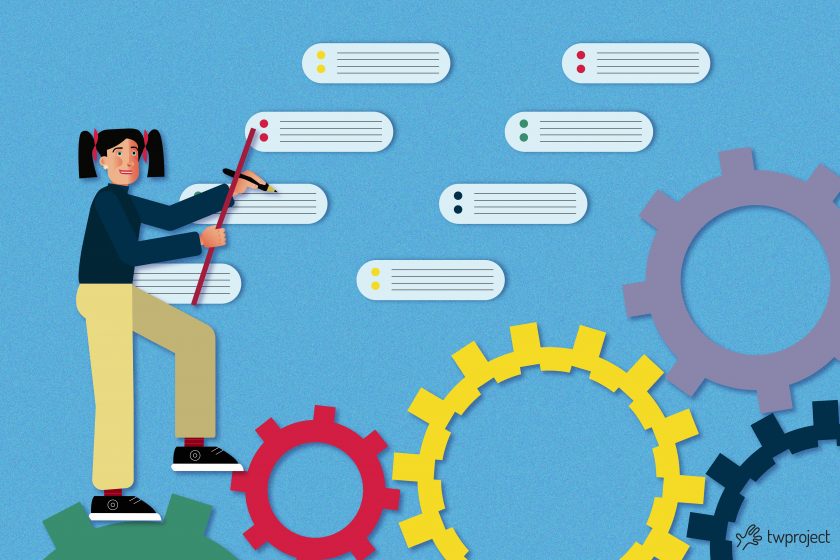A project implementation plan is a core strategic document that keeps the team’s work on track.
It is a tremendously valuable planning tool that can make or break your project’s success or failure.
It is a fairly comprehensive document, and it may be challenging for those who have never created one before.
However, don’t worry! This article will provide you with the steps to create and implement a project plan effectively.
CONTENT
- What is project implementation, and why is it important?
- What are the steps to follow for a successful project implementation?
- 1.Evaluate your project and determine roles
- 2.Implement a schedule
- 3.Make changes to your project if necessary
- 4.Analyze your project data
- 5.Collect feedback
- 6.Provide end-of-project reports
- Project implementation with Twproject
What is project implementation, and why is it important?
Project implementation involves rolling out a plan to generate satisfactory results for stakeholders.
This occurs after the planning phase, when the team determines key project objectives, timelines, and budget.
Implementation involves coordinating resources and measuring performance to ensure that the project remains within scope and budget.
It also involves managing potential issues to keep the project running smoothly.
This step in the process and how it is executed can determine the success or failure of a project.
Implementation is critical because it allows planning to become tangible actions, manages the workflow effectively, and adapts to unforeseen situations.
A project may run into bumps along the way, but managing resources and timelines can help keep it running without jeopardizing key objectives.
Moreover, a well-structured implementation ensures that each project can be monitored and measured relative to defined performance indicators, thus allowing timely changes to be made to improve results and ensure objectives are met.
Let’s take a look at the steps required to implement a project effectively.
What are the steps to follow for a successful project implementation?
There are different steps involved in implementing a project, including a certain amount of planning that must be carried out before implementation can begin:
1. Evaluate your project and determine roles
It is helpful to set a plan that meets the expectations of key stakeholders in the first phase of the project cycle.
Before implementing a project, the project manager must evaluate the plan and ensure that all team members understand what is required of them.
The project manager should also clearly communicate assigned roles and the expected schedule, as well as any project milestones that a team will be working toward in the execution phase.
2. Implement a schedule
Once a plan is up and running and expectations are established and clear, it is time to begin concrete work on the project. During this phase, the project manager should hold regular meetings with team members to discuss progress and any critical issues encountered.
At this stage, the project schedule is measured against the planned schedule, and resources are monitored to ensure that the team has what it needs to complete the project successfully.
Solid communication both ways is critical during this part of the process. It is also important to provide regular progress updates to clients or key stakeholders to ensure transparency about progress and to identify any problems as early as birth before it is too late.
3. Make changes to your project if necessary
Throughout any project, a project manager will likely need to make changes during implementation. These may occur due to new client requests or to keep the project within its scope.
During this phase, it becomes critical for a project manager to continue communicating with their team and asking questions to determine which areas they need more support in.
Change is not uncommon, but it is a reality for most projects, and the effectiveness with which a project manager implements these changes can affect the endeavor’s success.
4. Analyze your project data
During the implementation phase of a project, it is important to analyze data consistently to measure progress against initial projections. To do this, you can use a project management tool such as Twproject to gain insight into resource, budget, and schedule data.
Reviewing the data will help determine if any areas need to be changed to help the team meet the initial project expectations.

5. Collect feedback
The work is not over after the team has completed its project deliverables. Collecting feedback from the project team, clients, and stakeholders on the project results and evaluating which parts of the work went according to plan and which areas the team could improve the next time is critical to improving.
Project managers can have direct conversations with team members or send out a short survey to ask for input. This step can help companies make continuous improvements to ensure successful completion of future projects.
6. Provide end-of-project reports
The last part of the implementation phase includes providing reports to the project team, clients, and stakeholders outlining how the project performed against budget and schedule.
If changes were implemented during the project life cycle, these reports will also explain why these modifications were made.
They will include applicable data related to the project’s budget, timeline, and resources. This step is closely related to the feedback collection seen earlier. It gives companies the opportunity to reflect on project successes and identify any improvements needed for the future.
Project implementation with Twproject
Creating a project implementation plan involves careful planning and attention to countless details, but the results are worth the investment. This plan can increase a project’s success rate, team productivity, and morale.
Project implementation might seem tricky, but it becomes infinitely easier when you use the right tool.
Twproject comes with cutting-edge functionalities that support the entire project lifecycle, from early planning to final delivery. Thanks to its user-friendly interface, the team can collaborate more efficiently, sharing real-time information and updates.
This dramatically reduces the risk of errors due to fragmented communications or delays in data sharing.
As we have seen, projects rarely go as planned.
Twproject helps spot potential risks early and allows uncertainties to be overcome through sensible changes without affecting the project outcome.
Creating a project implementation plan with Twproject is no longer a daunting and complicated task; on the contrary, it is a clear path to follow.
This allows the project manager to stay focused on the goals and meet the stakeholders’ requirements.
Customized reports also provide a detailed overview of each project’s performance compared to initial projections, identifying areas for improvement and best practices to replicate in future projects.




